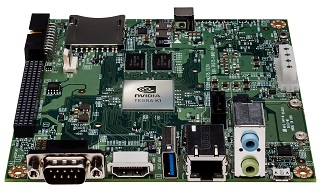|
You'll probably need a large motor with an encoder, but that isn't a bad plan. Check out Sparkfun's Robotics 101 videos, especially the first few on angular and linear motion https://www.sparkfun.com/videos/. They're pushing their robotics hardware pretty hard, but the concepts are universal and you may find a few of their items are exactly what you need.
|
|
|
|
|

|
| # ? May 23, 2024 22:14 |
|
Is there a place to order small servos that's a little more like Digikey than Sparkfun? Or should I just find the model I want and then search Ebay and Google?
|
|
|
|
Captain Cool posted:Is there a place to order small servos that's a little more like Digikey than Sparkfun? Or should I just find the model I want and then search Ebay and Google? I would check RC or hobby stores, they usually have tons of different servos: http://www.hobbyking.com/hobbyking/store/__84__189__Servos_Parts-All_Servos.html
|
|
|
|
mod sassinator posted:I would check RC or hobby stores, they usually have tons of different servos: http://www.hobbyking.com/hobbyking/store/__84__189__Servos_Parts-All_Servos.html I was also checking dealextreme since I'm making an order there anyway, and, um,
|
|
|
|
Maybe pololu? They're sort of sparkfun-y but more focused on robotics and have a pretty healthy selection of servos and related gear. http://www.pololu.com
|
|
|
|
|
Captain Cool posted:Thanks. I did see some hobby stores come up on Google but I didn't get that one. This is another chinese DX-like site: http://www.banggood.com/buy/servo.html I have never bought anything from them, though.
|
|
|
|
Is there any reason to get an UNO instead of a Leonardo? I own a micro (Leonardo based) and I'm thinking about getting a normal form Arduino.
|
|
|
|
Captain Cool posted:Thanks. I did see some hobby stores come up on Google but I didn't get that one. I have a whole pile of those. If all you need is a cheap, light duty servo for small projects they'll fit the bill quite nicely.
|
|
|
|
Acid Reflux posted:I have a whole pile of those. If all you need is a cheap, light duty servo for small projects they'll fit the bill quite nicely.
|
|
|
|
Amberskin posted:Is there any reason to get an UNO instead of a Leonardo? I own a micro (Leonardo based) and I'm thinking about getting a normal form Arduino. The uno allows you to remove and replace the microcontroller if you want to prototype your project into a standalone product.
|
|
|
|
Mantle posted:The uno allows you to remove and replace the microcontroller if you want to prototype your project into a standalone product. It's worth mentioning that there are some Unos that have an SMD microcontroller, which while technically removable, would be a tremendous pain to deal with.
|
|
|
|
Amberskin posted:Is there any reason to get an UNO instead of a Leonardo? I own a micro (Leonardo based) and I'm thinking about getting a normal form Arduino. If you have a micro I would go for the Leonardo then since it will have the same features.
|
|
|
|
Captain Cool posted:I was referring to the typo on the label in that picture. Doesn't give me high hopes of getting a genuine product. Doh! Completely missed that. Had to go check mine, they actually say "servo." 
|
|
|
|
mod sassinator posted:If you have a micro I would go for the Leonardo then since it will have the same features. Yeah, that is my intention. Just wondering if there was something I was not seeing about the UNO.
|
|
|
|
There are some differences in the way the serial port is handled on the Uno vs. the Leonardo, and the Uno has the removable microcontroller, but that's about it. The Uno has the really annoying and poorly designed type-B USB port too. If you want to program a discrete chip, though, you don't need an Uno to do it. Just buy the plain old chip (ATMega328 in 28-pin PDIP) from Mouser or DigiKey and wire it up with the ArduinoISP sketch (google it) and you're good to go. You can also program ATTiny85, 2313 and a few others this way.
|
|
|
|
Captain Cool posted:I was referring to the typo on the label in that picture. Doesn't give me high hopes of getting a genuine product. If you buy cheap servos from a site in China it is virtually guaranteed that you are not getting a "genuine product." What you get may be equally functional or even come off the same production line, but it is definitely a ripoff in one way or another.
|
|
|
|
I get this weird thing every now and then after uploading new code to my Uno. My debug messages sometimes come out with the first few characters garbled in the beginning. code:It's harmless but a bit odd.
|
|
|
|
Is your serial port set to the correct baud rate?
|
|
|
|
Yeah, both the arduino and serial monitor are set to 9600bps. It works most of the time but the odd time the first few dozen bytes end up garbage.
|
|
|
|
I've seen garbage like that if the serial port is open when the Arduino is restarted. I think it might have to do with the bootloader--for a short period of time while the Arduino is loading up it looks for any attached programmer and might be sending some junk on the serial port.
|
|
|
|
I've also seen similar when there was too much of a draw or the power was lovely.
|
|
|
|
mod sassinator posted:I've seen garbage like that if the serial port is open when the Arduino is restarted. I think it might have to do with the bootloader--for a short period of time while the Arduino is loading up it looks for any attached programmer and might be sending some junk on the serial port.
|
|
|
|
Also, it bears mentioning that opening the serial monitor in the arduino environment resets the arduino and you'll often see garbage output left over from that.
|
|
|
|
|
Just a heads up. Some days ago I asked about reasons to choose an UNO over a Leonardo. Now I have one: the Leonardo bootloader eats 4KB of flash memory, while the UNO uses just half kilobyte. I'm trying to drive a LCD using this library http://henningkarlsen.com/electronics/library.php?id=51 and the demo programs just don't fit in the Leonardo. They are about 30KB in size, while the leonardo available flash is about 28K. I'm pretty sure there are smaller libraries around (and I think I would be able to strip down UTFT to make it fit), but looking at the price of the arduino compatible boards sold by chinese manufacturers I'm just getting an UNO (and a mega to be able to use 16 bit addressing for the TFT).
|
|
|
|
Anyone here tried playing with the CapacitiveSensor library? I'm having trouble getting it to work. I'm just using the example sketch, but all I ever get is -2. I tried upping the timeout to as much as 8 seconds, no change. I've got a 1MΩ resistor from pin 2 to 4, and a wire going to a copper pad on pin 2. The pad is about 1 square inch, on the end of about 12" of wire. The resistor is on the low end from what I've read, but still within range. I also tried a 47kΩ resistor, no change. And three 1MΩ resistors in series, no change. not sure if it matters but I'm doing this on a teensy 3.0. I feel like I should at least get SOMETHING besides that error code as long as I have it wired up right. And I've checked and re-checked the pins according to the pinout chart from pjrc, scroll down to Teensy 3.0 pins, I'm using Digital Pins 2 and 4. Any ideas?  Fortunately, I have a backup plan for this, but I probably should have made a proof of concept before I designed and ordered a board based on this working. 
|
|
|
|
|
Bad Munki posted:Anyone here tried playing with the CapacitiveSensor library? I'm having trouble getting it to work. I'm just using the example sketch, but all I ever get is -2. I tried upping the timeout to as much as 8 seconds, no change. I've got a 1MΩ resistor from pin 2 to 4, and a wire going to a copper pad on pin 2. The pad is about 1 square inch, on the end of about 12" of wire. The resistor is on the low end from what I've read, but still within range. I also tried a 47kΩ resistor, no change. And three 1MΩ resistors in series, no change. not sure if it matters but I'm doing this on a teensy 3.0. I feel like I should at least get SOMETHING besides that error code as long as I have it wired up right. And I've checked and re-checked the pins according to the pinout chart from pjrc, scroll down to Teensy 3.0 pins, I'm using Digital Pins 2 and 4. I just did this yesterday! I ended putting the resistor on the output pin instead of the sense pin. For added fun inline the resistor with the out put and airgap the sense wire and see how close you get your hand. -------------- I2C - or how an arduino is going to kill me. I'm on a kindle so I'll bare minimum this. Connections: arduino uno pin 5 to MCP23008 pin 1 Uno pin 4 to mcp pin 2 4.7k pull ups on both Mcp pins 3,4,5 to GND (0x20 device address) also pin 9 (chip gnd) mcp pin 6 (reset) to 5v also pin 18 (vcc) Mcp pin 9 (gp0) to and led in series with a 220ohm resistor then into ground. _--------------- The problem. I'm unable to get the led to ever turn on. Ive been working with example code from the wire library references. One migrane later i'm asking for help.
|
|
|
|
I've got MCP23017s which are similar, and an Uno but never used them with each other so I can't speak for how the libraries work But do the examples say to use pins 4 and 5? because there are dedicated I2C SCL and SDA lines on the top left hand side of my arduino. :edit: I've looked it up and yeah the A4 and A5 lines are i2c also so you've probably wired it up right in that sense Can you post a sample of the code you're using? theperminator fucked around with this message at 10:22 on Mar 26, 2014 |
|
|
Kasan posted:I just did this yesterday! I ended putting the resistor on the output pin instead of the sense pin. So it must be something I'm doing wrong. Even if I swapped where the sensor was, I would still expect to see something besides the -2 error code on the output. I wonder if there's some difference between the arduino and the teensy that make this library not work as expected. I'll have to dig out an old arduino to see if I can get it going with that.
|
|
|
|
|
If you're using A4 and A5, they have internal pull-ups, so the 4.7ks might not be necessary. I've used I2C for communication between two Arduinos and never needed external pull-ups. e: actually between one arduino and one Teensy 2.0. I have no idea if the Teensy 3 has a similar setup or what.
|
|
|
|
Sagebrush posted:If you're using A4 and A5, they have internal pull-ups, so the 4.7ks might not be necessary. I've used I2C for communication between two Arduinos and never needed external pull-ups. You have to enable the pullups in your code though: code:
|
|
|
|
Looking at Wire.cpp I found this linecode:
|
|
|
|
Well I managed to solve my own question after staring at my code, example code, tutorials that have nothing to do with what I was trying to do beyond using I2C and the datasheet for the MCP23008. Turns out my problem was I didn't understand register addressing even remotely. (horray for beginners) An example code block would be something like. code:The end result is a new problem that I wasn't able to figure out. How do I write to pin 17? It's listed in the date sheet as GPO7, but to address it I would need to use 8 bits, and the chip only allows the writing of 7 bits (the 8th bit being a directional bit that's automatically set from the IODIR register.) How I do use this elusive bit and make full use of the 8 I/O pins? Circuit porn: 
|
|
|
|
Regarding the last paragraph, I don't think that's right. I have no idea what you're talking about re: 8th bit. If you want to set pin 17 high it should be as simple as writing 0x80 to the IO Register. i.e Wire.beginTransmission(0x20); Wire.write(0x09); Wire.write(0x80); Wire.endTransmission(); delay(500);
|
|
|
|
SparkFun is having a big sale for Arduino Day this Saturday. Great time to pick up a couple of cheap boards if you need them.
|
|
|
|
I picked up a Sainsmart Uno with the 328 chip for $11 shipped the other day, shipped from Hong Kong in about 8 days. It blinks and does all the basic stuff you would expect it to http://www.sainsmart.com/sainsmart-uno-atmega328p-pu-atmega8u2-microcontroller-for-arduino.html Also, nVidia announced their Jetson TK1 board, it's sort of like a turbocharged Beagle Board, it't $192; basically a DIY chromebox https://developer.nvidia.com/jetson-tk1 Tegra SOC, Kepler GPU + ARM Cortex A15 2GB ram, 16gb onboard storage, SD card, multiple USB, full size HDMI, dedicated audio jacks, gig-e, tons of GPIOs and a couple PWM pins 127mm x 127mm 
Hadlock fucked around with this message at 04:07 on Mar 28, 2014 |
|
|
|
Hadlock posted:I picked up a Sainsmart Uno with the 328 chip for $11 shipped the other day, shipped from Hong Kong in about 8 days. It blinks and does all the basic stuff you would expect it to I got yesterday my order from banggood, with an UNO R3 for 8.51€ and a Mega2560 for 11.39€. Wait time: aproximately 15 days. http://www.banggood.com/Wholesale-Arduino-SCM-And-3D-Printer-Acc-c-2153.html
|
|
|
|
CygnusTM posted:SparkFun is having a big sale for Arduino Day this Saturday. Great time to pick up a couple of cheap boards if you need them. Everything is (unsurprisingly) already sold out on the site, but they're allowing backorders. Pro Minis are only $3.00!
|
|
|
|
Hey folks. I just picked up my first arduino a couple of days ago after trying to figure out the best way to accomplish some in-car indicator projects. I've got coding background (Perl, VB), and as a few people have said in the thread previously, going from on-screen results to in-world results is something magical. I'm not sure why I didn't get into arduino years ago when I first heard about it. Anyhow, my first project was to tear apart the Blink tutorial that comes w/ the software and make a little 5-LED Knight-Rider light array. The code is just an array holding the pin identifiers, a couple of for-loops that cycle through the LEDs, and that's basically it. SPOILER ALERT: Don't get too excited before you click on it. It's nothing that will be mounted in a car at this stage. It's just a proof of concept. https://www.youtube.com/watch?v=o6oFqNHbDlU This is so much fun, though.
|
|
|
|
Private video is private. 
|
|
|
|

|
| # ? May 23, 2024 22:14 |
|
jovial_cynic posted:Anyhow, my first project was to tear apart the Blink tutorial that comes w/ the software and make a little 5-LED Knight-Rider light array. Are you using the delay() function or timers? delay() is bad because the command literally just sleeps the entire CPU for n milliseconds so you can't do anything else in the meantime. A better method is code:
|
|
|



















